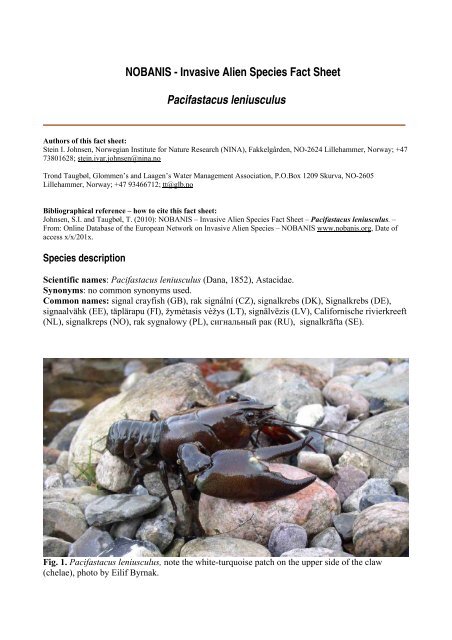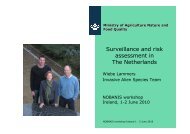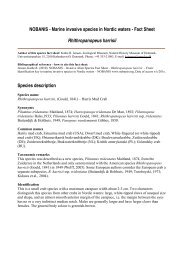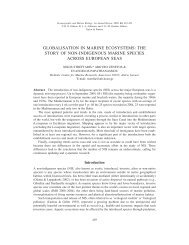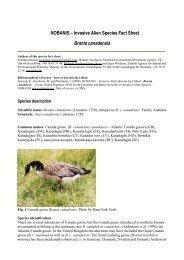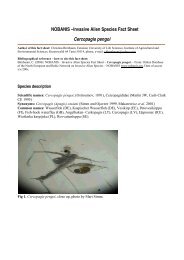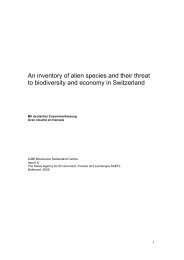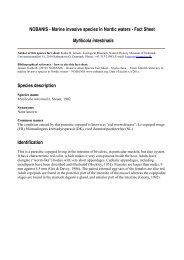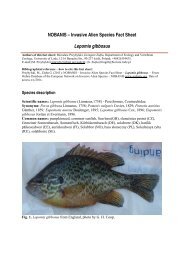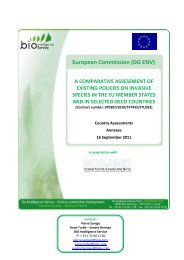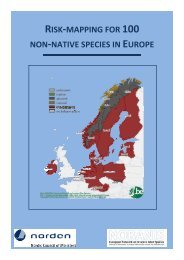Pacifastacus leniusculus - NOBANIS
Pacifastacus leniusculus - NOBANIS
Pacifastacus leniusculus - NOBANIS
You also want an ePaper? Increase the reach of your titles
YUMPU automatically turns print PDFs into web optimized ePapers that Google loves.
<strong>NOBANIS</strong> - Invasive Alien Species Fact Sheet<br />
<strong>Pacifastacus</strong> <strong>leniusculus</strong><br />
Authors of this fact sheet:<br />
Stein I. Johnsen, Norwegian Institute for Nature Research (NINA), Fakkelgården, NO-2624 Lillehammer, Norway; +47<br />
73801628; stein.ivar.johnsen@nina.no<br />
Trond Taugbøl, Glommen’s and Laagen’s Water Management Association, P.O.Box 1209 Skurva, NO-2605<br />
Lillehammer, Norway; +47 93466712; tt@glb.no<br />
Bibliographical reference – how to cite this fact sheet:<br />
Johnsen, S.I. and Taugbøl, T. (2010): <strong>NOBANIS</strong> – Invasive Alien Species Fact Sheet – <strong>Pacifastacus</strong> <strong>leniusculus</strong>. –<br />
From: Online Database of the European Network on Invasive Alien Species – <strong>NOBANIS</strong> www.nobanis.org, Date of<br />
access x/x/201x.<br />
Species description<br />
Scientific names: <strong>Pacifastacus</strong> <strong>leniusculus</strong> (Dana, 1852), Astacidae.<br />
Synonyms: no common synonyms used.<br />
Common names: signal crayfish (GB), rak signální (CZ), signalkrebs (DK), Signalkrebs (DE),<br />
signaalvähk (EE), täplärapu (FI), žymėtasis vėžys (LT), signālvēzis (LV), Californische rivierkreeft<br />
(NL), signalkreps (NO), rak sygnałowy (PL), сигнальный рак (RU), signalkräfta (SE).<br />
Fig. 1. <strong>Pacifastacus</strong> <strong>leniusculus</strong>, note the white-turquoise patch on the upper side of the claw<br />
(chelae), photo by Eilif Byrnak.
Species identification<br />
The signal crayfish is similar to and can be confused with the noble crayfish (Astacus astacus)<br />
which is native to parts of the region. The signal crayfish is distinguished from the noble crayfish,<br />
both as juvenile and adult, by the more smooth nature of the chelae and the lack of a row of spines<br />
on the shoulders of carapace behind cervical groove. The white-turquoise patch on the upper side of<br />
the chelae is also unique to the adult signal crayfish (Fiskeriverket/Naturvårdsverket 2005, Lewis<br />
2002, Pöckl et al. 2006).<br />
Native range<br />
The native range of the signal crayfish is the northwestern USA and southwestern Canada where it<br />
occurs from British Columbia in the north, central California in the south, and Utah in the east<br />
(Lewis 2002).<br />
Alien distribution<br />
History of introduction and geographical spread<br />
In 1960, a small batch of signal crayfish was introduced to Sweden from California, USA, in an<br />
attempt to find a species which could replace the populations of the indigenous noble crayfish,<br />
which was severely depleted by the crayfish plague from 1907 onwards<br />
(Fiskeriverket/Naturvårdsverket 1998). The signal crayfish was considered to occupy the same<br />
ecological niche and presumed to be able to restore the recreational and commercial important<br />
crayfish fishery in the plague affected areas. The fact that it was also a carrier of crayfish plague<br />
was unknown at the time (Unestam 1972). Trials were successful and in 1967-69, a large number of<br />
signal crayfish were imported from USA and introduced into Swedish and Finnish waters (Lowery<br />
and Holdich 1988, Westman 1995). These were followed by further secondary introductions,<br />
including large numbers of domestic hatchery-reared juveniles. Further introductions, especially of<br />
juveniles from Sweden, were made to many European countries (Lowery and Holdich 1988). The<br />
signal crayfish is at present most established in Sweden where it occurs in approximately 4000<br />
localities (Edsman and Schröder 2009). An increasing number of signal crayfish introductions have<br />
taken place during the last 30 years in Denmark and this illegal practice still goes on. The crayfish<br />
has been released in many small lakes, wherefrom it has spread to a number of the larger river<br />
system on Zealand and in Jutland. In the summer 2010 it was found in coastal waters in the Danish<br />
part of the Baltic Sea as well (Eilif Byrnak, pers. comm.; Søren Berg, pers. comm..). In Austria,<br />
2000 signal crayfish were imported in summer 1970 from California and released in several<br />
provinces. Today, the species is present in all provinces, widely distributed, particularly in the<br />
eastern provinces, and locally abundant. The crayfish was introduced to Czech Republic in 1980<br />
from Sweden for commercial production. Until 2006, the signal crayfish was recorded in 24<br />
European countries/regions (Souty-Grosset et al. 2006). Signal crayfish was recorded in Norway in<br />
2006 (Johnsen et al. 2007), but this population is now most likely eradicated with chemicals<br />
(Sandodden and Johnsen 2010). However, signal crayfish was recorded in a larger watercourse in<br />
south-eastern Norway in 2008 (Johnsen and Vrålstad 2009). Records of signal crayfish in Norway,<br />
Slovakia (Maguire et al. 2008) and Croatia (Petrusek and Petruskova 2007) extends the list from<br />
2006 (Souty-Grosset et al. 2006) to 27 European countries/regions (Holdich et al. 2009). This<br />
makes the signal crayfish the most widely spread alien freshwater crayfish species in Europe<br />
(Souty-Grosset et al. 2006, Holdich et al. 2009). In the Nordic-Baltic region it is found/established<br />
in all countries except Russia (nor in Iceland, Greenland and Faroe Islands where no freshwater<br />
crayfish species occur). In 2008 the first specimen was found in Estonia (Hurt and Kivistik 2009).<br />
2
Fig. 2. Present distribution of signal crayfish (<strong>Pacifastacus</strong> <strong>leniusculus</strong>) in Europe. © Publications<br />
Scientifique MNHN, Paris, 2006. (After Souty-Grosset et al. 2006). The records of signal crayfish<br />
in Norway (Johnsen and Vrålstad 2009, Slovakia (Maguire et al. 2008) and Croatia (Petrusek and<br />
Petruskova 2007), Estonia (Hurt and Kivistik 2009) and Jutland, Denmark (E. Byrnak pers. comm.)<br />
are not represented in the map.<br />
Pathways of introduction<br />
The most common pathway of introduction into natural waters is stocking by humans. In the 1970-<br />
80s the stocking policy in the region was liberal, and the signal crayfish was introduced legally into<br />
a large number of natural waters. From the late 1980s onwards, the introduction of the signal<br />
crayfish into new areas was restricted by the environmental authorities due to the threat it posed to<br />
the indigenous, red-listed noble crayfish (Troschel and Dehus 1993, Skurdal et al. 1999, Edsman<br />
2004). However, the distribution of the signal crayfish is still rapidly increasing, including more and<br />
more watercourses. The crayfish can spread by natural migration only within a watercourse,<br />
between migration barriers. Most of the current spread is therefore due to illegal introductions by<br />
humans.<br />
Alien status in region<br />
The signal crayfish has been introduced to all countries in the region, except Russia and the North<br />
Atlantic Islands (see table 1). In Estonia, one specimen of signal crayfish was found in R.<br />
Mustjõgi (northern Estonia) in 2008. In 2009, a bigger survey was carried out, no alien crayfish was<br />
found, but no native crayfish was found where the alien crayfish had been found previously. Thus,<br />
the signal crayfish might have been the carrier of crayfish plague (Hurt and Kivistik 2009). It is<br />
very common in Sweden and Finland, common in Germany, Denmark and Austria and found in a<br />
more limited number of localities in Poland, Lithuania and Latvia (Souty-Grosset et al. 2006). In<br />
Norway, signal crayfish is now only confirmed to exist in one locality (Johnsen and Vrålstad 2009).<br />
3
Country Not Not Rare Local Common Very<br />
found established<br />
common<br />
Austria<br />
Belgium<br />
X<br />
Czech republic X<br />
Denmark X<br />
Estonia X<br />
European part of Russia X<br />
Finland X<br />
Faroe Islands X<br />
Germany X<br />
Greenland X<br />
Iceland X<br />
Ireland X<br />
Latvia X<br />
Lithuania X<br />
Netherlands X<br />
Norway X<br />
Poland<br />
Slovakia<br />
X<br />
Sweden X<br />
Not<br />
known<br />
Table 1. The frequency and establishment of <strong>Pacifastacus</strong> <strong>leniusculus</strong>, please refer also to the<br />
information provided for this species at www.nobanis.org/search.asp. Legend for this table: Not<br />
found –The species is not found in the country; Not established - The species has not formed selfreproducing<br />
populations (but is found as a casual or incidental species); Rare - Few sites where it is<br />
found in the country; Local - Locally abundant, many individuals in some areas of the country;<br />
Common - Many sites in the country; Very common - Many sites and many individuals; Not<br />
known – No information was available.<br />
Ecology<br />
Habitat description<br />
The native habitat of the signal crayfish ranges from small streams to large rivers, and lakes from<br />
the coastal to the sub-alpine regions. Signal crayfish can also survive in brackish water (Holdich et<br />
al. 1997). The distribution of the signal crayfish in Europe comprises the same range of habitats<br />
(Souty-Grosset et al. 2006).<br />
Reproduction and life cycle<br />
The signal crayfish has a typical life cycle of a member of the crayfish family Astacidae (Lewis<br />
2002). Mating and egglaying occurs during autumn, mainly in October. Egg numbers usually range<br />
from 200 to 400. After egg laying the female carry the eggs under the tail until hatching. Hatching<br />
time varies greatly depending on temperature, and in natural populations it may occur from late<br />
March to the end of July. The eggs hatch into miniature crayfish that stay with the mother for three<br />
stages (two moults). In the third stage the juvenile crayfish gradually become more and more<br />
independent of the mother, adopting a solitary life. Size at maturity is usually 6-9 cm total-length<br />
(from tip of head to edge of tail-fan) at an age of 2-3 years. Estimates of survivorship to age 2 vary<br />
from 10-52%, being dependent on both abiotic and biotic factors. Competition and cannibalism can<br />
4
greatly affect survival in dense populations. Maximum age and size are reported to be approx. 20<br />
years and 16-18 cm, but such sizes are very seldom.<br />
Dispersal and spread<br />
Humans are the overall most important vector for dispersal and spread (see above) of the signal<br />
crayfish. Due to fisheries in natural waters in most regions where it occurs, signal crayfish are easily<br />
accessible as stocking material. Within the watercourse the signal crayfish can spread by own<br />
migration. Upstream migration rates of more than 1 km per year are reported from rivers in Finland<br />
and England. Downstream spread can be faster (Westman and Nylund 1979, Guan and Wiles<br />
1997a, Peay and Rogers 1999). There are also indications that the signal crayfish may pass dams<br />
and waterfalls by walking on dry land (Hiley 2003). Probably this behaviour is triggered by high<br />
density or other unfavourable conditions. Normally, the crayfish would not leave the water and<br />
expose itself to great predation risk on land, but at least this shows its potential for self dispersal.<br />
Impact<br />
Affected habitats and indigenous organisms<br />
The signal crayfish occupies the same ecological niche as the indigenous noble crayfish. It occurs<br />
mainly in localities previously inhabited by these species, and maintains in general the same effects<br />
on natural habitats. It is considered to be a non-burrowing species in North America, but in Europe<br />
it constructs burrows in river and lake banks (Holdich and Reeve 1991), similar to the noble<br />
crayfish. As an opportunistic polytrophic feeder it also consumes detritus and thereby plays an<br />
important role in the degradation and mineralization of dead organic matter. It may exert a<br />
significant grazing pressure on macrophytes, aquatic insects, snails, benthic fishes and amphibian<br />
larvae. Several studies indicate that signal crayfish have a stronger impact on the food web structure<br />
than the indigenous noble crayfish (Guan and Wiles 1997b, Nyström 1999, 2002 and references<br />
herein).<br />
The most severe effect of the signal crayfish is the extermination of the noble crayfish, caused by<br />
the transmission of the crayfish plague (another invasive species) (Alderman 1997). Indigenous<br />
European crayfish species have no resistance to against this disease and experience total mortality.<br />
American crayfish species on the other hand have co-evolved with the crayfish plague and<br />
developed defence systems making them a natural host for and carrier of this parasitic disease<br />
(Unestam 1972, Evans and Edgerton 2002). Most, if not all, signal crayfish are infected by the<br />
crayfish plague. Thus, if a signal crayfish population is established in a watercourse, the crayfish<br />
plague is also established, and there is no possibility for the noble crayfish to co-exist. For this<br />
reason, the spread of signal crayfish is the most serious threat to the indigenous noble crayfish.<br />
Genetic effects<br />
No hybrids with other crayfish species have been reported. Signal crayfish can mate with noble<br />
crayfish, but the eggs are not fertile.<br />
Human health effects<br />
No human health effects have been reported, although allergies towards shellfish may occur.<br />
Economic and societal effects (positive/negative)<br />
In many countries in the region, especially Sweden and Finland, the signal crayfish populations<br />
support a large, commercially and recreationally important, fishery (Ackefors 1999). In Europe as a<br />
whole, a total of 355 tonnes of signal crayfish was estimated from capture fisheries in 1994<br />
5
(Ackefors 1998). This level has increased considerably, and in 2001 the Swedish catch was<br />
estimated to 1200 tonnes. In recent years, however, levels have dropped for unknown reasons.<br />
Viruses in combination with a chronic plague infection have been suspected as a possible reason<br />
(Söderhäll 2004). The amount of cultured amount of signal crayfish in Sweden was estimated to 42<br />
tonnes in 1996 (Ackefors 1998).<br />
The most serious negative effect of the signal crayfish is the extermination of the indigenous noble<br />
crayfish, due to the uncontrolled spread of the signal crayfish to more and more watercourses. The<br />
noble crayfish has great sociocultural/-economic traditions in the region (Swahn 2004) and is more<br />
valuable than the signal crayfish, also from the pure economic point of view. First and foremost<br />
because of the uncontrolled spread of signal crayfish, the noble crayfish is recognized as a<br />
threatened species included in the international Red List, the Bern Convention and EU’s Habitat<br />
Directive.<br />
Management approaches<br />
Prevention methods<br />
Preventing the further introduction of signal crayfish to new water bodies by humans is the greatest<br />
management challenge (for efforts, see below). In most countries in the region the introduction of<br />
live non-indigenous crayfish species, like the signal crayfish, is not permitted (Skurdal et al. 1999).<br />
In Latvia the import of live crayfish is allowed, only a veterinary certificate is needed (Arens and<br />
Taugbøl 2005). In all countries stocking of live crayfish in natural waters requires permission from<br />
the authorities. The lack of effective control and enforcement is, however, a problem.<br />
Eradication, control and monitoring efforts<br />
When the signal crayfish is established in a water body there is no practical way of eradication,<br />
except perhaps in very small, enclosed waterbodies where insecticides or other chemicals might be<br />
applied (Sandodden and Johnsen 2010). Extensive trapping may reduce population density and slow<br />
down the speed at which it spreads naturally, but it is not an effective control method. There is<br />
important research into pheromone trapping of male signal crayfish (Stebbing et al. 2004, Stebbing<br />
et al. 2005), this method could become in the future be used as a control and eradication method.<br />
Monitoring of the distribution and identifying new populations by test-fishing provide important<br />
information necessary in a management strategy. Monitoring of crayfish distribution and occurrence<br />
takes place in several countries in the region and reveals that illegal signal crayfish introductions<br />
occur to a large extent and is the major reason for further spread.<br />
Information and awareness<br />
The key factor to prevent further spread of the signal crayfish is information about the negative<br />
effects. It is imperative to convince landowners/fishermen that the indigenous noble crayfish is the<br />
best alternative for crayfish harvest. With live signal crayfish easily accessible from natural waters<br />
not far away, it is impossible to prevent (illegal) stocking if local people want to do so. Information<br />
campaigns, including folders/brochures, media contact and education in schools are important.<br />
Likewise concrete projects aimed at conservation and sustainable use of noble crayfish and the<br />
prevention of further spread of signal crayfish, through information and involvement of relevant<br />
interest groups. The so-called “Astacus”-project, an inter-regional collaboration project between<br />
Norway and Sweden, is an example of such a project (www.astacus.org).<br />
6
Knowledge and research<br />
Several research topics have been carried out on the signal crayfish in the region, especially in<br />
Sweden and Finland. Prevalent topics are on its ecology, immunology, behaviour, population<br />
biology and environmental impact (see Nyström 1999, 2002, Söderhäll and Söderhäll 2002 and<br />
references herein). There has also been some research into improving methods for its culture.<br />
Recommendations or comments from experts and local communities<br />
Signal crayfish should be managed as a valuable resource for recreational and commercial fishery in<br />
areas where it is established (Ackefors 1999, Taugbøl and Skurdal 1999). In other areas where the<br />
noble crayfish still has a chance to survive, the great values of this species should be emphasized,<br />
and it should be made clear to all stakeholders that the spread of signal crayfish to these areas is a<br />
tragedy to nature and to the socioeconomic/-cultural values the noble crayfish represents. In<br />
addition it is an environmental crime.<br />
Furthermore, in the light of decreasing catches and numerous collapses of signal crayfish<br />
populations in recent years, there is no guarantee that stocking of signal crayfish will give a<br />
harvestable population in the long run.<br />
References and other resources<br />
Contact persons<br />
Lennart Edsman (SE) Swedish Board of Fisheries, Freshwater Laboratory, Stångholmsvägen 2, SE-<br />
178 93 Drottningholm, Sweden; Phone: + 46 8-699 06 00, Fax: +46 8-699 06 50; E-mail:<br />
Lennart.Edsman@fiskeriverket.se<br />
Stein I. Johnsen (NO) Norwegian Institute for Nature Research, Fakkelgaarden, NO-2624<br />
Lillehammer, Norway; Phone: +47 73801628; E-mail: stein.ivar.johnsen@nina.no<br />
Stefan Nehring (DE) Federal Agency for Nature Conservation, Konstantinstrasse 110, D-53179<br />
Bonn; Phone: +49-228-84911444; E-mail: stefan.nehring@bfn.de<br />
Eilif Byrnak (DK) Natur and Miljø, Vestsjællands Amt, Alleen 15, DK-4180 Sorø; Denmark<br />
Phone: +45 57872829; E-mail: eby@vestamt.dk<br />
Gudni Gudbergsson (IS) Institute of Freshwater Fisheries, Vagnhofdi 7, IS-110 Reykjavik, Iceland;<br />
Phone: +354 5676400; E-mail: gudni.gudbergsson@veidimal.is<br />
Augusts Arens (LV) Latvian Crayfish and Fish Farmers' Association, 7-6 Alberta St., Riga LV-<br />
1010, Latvia; Phone/fax: +371-7-336-005; E-mail: earens@latnet.lv<br />
Przemyslaw Smietana (PL) University of Szczecin, Department of Ecology, ul. Waska 13, PL-71-412<br />
Szczecin, Poland; E-mail: leptosp@univ.szczecin.pl<br />
Margo Hurt (EE) Department of Fishery, Estonian University of Life Sciences, Krutzwaldi 48, EE-<br />
51006 Tartu, Estonia; Phone: + 372 731 3481; E-mail: margo.hurt@emu.ee<br />
Ari Mannonen(FI) Crayfish Innovation Center, Päijänne-Institute, Koulutuskeskus Salpaus,<br />
Laurellintie 55, FI-17320 Asikkala, Finland; Phone: +358 40 7082524; E-mail:<br />
raputietokeskus@jippii.fi<br />
7
Links<br />
The International Association of Astacology (IAA)<br />
Global Invasive Species Data Base - <strong>Pacifastacus</strong> <strong>leniusculus</strong> (ISSG - Invasive Species Specialist<br />
Group)<br />
References<br />
Ackefors, H. 1998. The culture and capture crayfish fisheries in Europe. World Aquaculture 29: 12-24, 64-67.<br />
Ackefors, H. 1999. The positive effects of established crayfish introductions in Europe, in: Gherardi, F. and Holdich, D.<br />
M. (Eds), Crayfish in Europe as alien species. How to make the best of a bad situation. A. A. Balkema, Rotterdam:<br />
49-61.<br />
Alderman, D.J. 1997. History of the spread of crayfish plague in Europe, in: Crustaceans: Bacterial and fungal<br />
diseasaes. QIE Scientific and Technical Review 15: 15-23.<br />
Arens, A. and Taugbøl, T. 2005. Status of freshwater crayfish in Latvia. Bulletin Français de la Pêche et de la<br />
Pisciculture (376-377): 519-528.<br />
Edsman, L. 2004. – The Swedish story about import of live crayfish. Bulletin Français de la Pêche et de la Pisciculture<br />
(372-373): 281-288.<br />
Edsman L. and Schröder S. 2009. Åtgärdsprogram för Flodkräfta 2008–2013 (Astacus astacus),<br />
Fiskerivertet och Naturvårdsverket, Rap. 5955, 67 p.<br />
Evans L. H. and Edgerton B. F. 2002. – Pathogens, parasites and commensals, in Holdich D. M. (Ed.), Biology of<br />
freshwater crayfish. Blackwell Science, Oxford: 377-438.<br />
Fiskeriverket/Naturvårdsverket 1998. Åtgärdsprogram för bevarande av flodkräfta.<br />
Fiskeriverket/Naturvårdsverket 2005. Information folder. Web-version<br />
Guan, R-Z. and Wiles, P.R. 1997a. The home range of signal crayfish in a British lowland river. Freshwater Forum 8:<br />
45-54.<br />
Guan, R.-Z. and Wiles, P.R. 1997b. Ecological impact of introduced crayfish on benthic fishes in a British lowland<br />
river. Conservation Biology 11: 641-647.<br />
Hiley, P.D. 2003. The slow quiet invasion of signal crayfish (<strong>Pacifastacus</strong> <strong>leniusculus</strong>) in England – prospects for the<br />
white-clawed crayfish (Austropotamobius pallipes). Pp. 127-138 in: Holdich, D.M. and Sibley, P.J. (eds.)<br />
Management and Conservation of Crayfish. Proceedings of a conference held on 7 th November, 2002. Environment<br />
Agency, Bristol, 217 pp.<br />
Holdich, D. M, Harlioglu, M. M. and Firkins, I. 1997. Salinity adaptations of crayfish in Brittish Waters with particular<br />
reference to Austropotamobius pallipes, Astacus leptodactylus and Pasifastacus <strong>leniusculus</strong>. Estuarine, Coastal and<br />
Shelf Science 44: 147-154.<br />
Holdich, D. M., and Reeve, I. D. 1991. Alien crayfish in the British Isles. Report for the National Environment Research<br />
Council, Swindon.<br />
Holdich, D.M., Reynolds, J.D., C. Souty-Grosset, C. and Sibley, P.J. 2009. A review of the ever increasing threat to<br />
European crayfish from non-indigenous crayfish species. Knowledge and Management of Aquatic Ecosystems 394-<br />
395, 11.<br />
Hurt, M. and Kivistik, M. 2009 Signaalvähi ja jõevähi levik ja arvukus Jägala jõestikus. Report for the Ministry of the<br />
Environment.<br />
Johnsen, S.I., Taugbøl, T., Andersen, O., Museth, J. and Vrålstad, T. 2007. The first record of the non-indigenous signal<br />
crayfish Pasifastacus <strong>leniusculus</strong> in Norway. Biological Invasions 9: 939-941.<br />
Johnsen, S.I. and Vrålstad T., 2009. Signal crayfish and crayfish plague in the Halden watercourse –<br />
proposition for a measurement plan, NINA Report 474, 29 p.<br />
Lewis, S.D. 2002. <strong>Pacifastacus</strong>, in Holdich D. M. (Ed.), Biology of freshwater crayfish. Blackwell Science, Oxford:<br />
511-540.<br />
Lowery R. S. and Holdich D. M. 1988. <strong>Pacifastacus</strong> <strong>leniusculus</strong> in North America and Europe, with details of the<br />
distribution of introduced and native crayfish species in Europe, in Holdich D. M. and Lowery R. S. (Eds),<br />
Freshwater crayfish: biology, management and exploitation. Croom Helm, London: 283-308.<br />
Maguire I., Klobucar, G., Marcic, Z. and Zanella D., 2008. The first record of <strong>Pacifastacus</strong> <strong>leniusculus</strong> in<br />
Croatia. Crayfish News: IAA Newsletter, 30, 4, 4.<br />
Nyström P. 1999. Ecological impact of introduced and native crayfish on freshwater communities: European<br />
perspectives, in Gherardi, F. and Holdich, D. M. (Eds), Crayfish in Europe as alien species. How to make the best of<br />
a bad situation. A. A. Balkema, Rotterdam: 63-85.<br />
Nyström P. 2002. Ecology, in: Holdich, D. M. (Ed.), Biology of freshwater crayfish. Blackwell Science, Oxford: 192-<br />
235.<br />
8
Peay, S. and Rogers, D. 1999. The peristaltic spread of signal crayfish (<strong>Pacifastacus</strong> <strong>leniusculus</strong>) in the River Wharfe,<br />
Yorkshire, England. Freshwater Crayfish 12: 665-676.<br />
Petrusek A. and Petruskova T. 2007. Invasive American crayfish <strong>Pacifastacus</strong> <strong>leniusculus</strong> (Decapoda:<br />
Astacidae) in the Morava River (Slovakia). Biologie, Bratislava, 62(3): 356–359.<br />
Pöckl M, Holdich DM and Pennerstorfer J (2006) Identifying native and alien crayfish species in Europe. Craynet, p 47.<br />
Sandodden, R. and Johnsen, S. I. 2010. Eradication of introduced signal crayfish Pasifastacus <strong>leniusculus</strong> using the<br />
pharmaceutical BETAMAX VET.®. Aquatic Invasions 5(1): 75-81.<br />
Skurdal J., Taugbøl T., Burba A., Edsman L., Söderbäck B., Styrishave B., Tuusti J. and Westman K. 1999. Crayfish<br />
introductions in the Nordic and Baltic countries, in Gherardi, F. and Holdich, D. M. (Eds), Crayfish in Europe as<br />
alien species. How to make the best of a bad situation. A. A. Balkema, Rotterdam: 193-219.<br />
Souty-Grosset C., Holdich D.M., Noël P.Y., Reynolds J.D. and Haffner P. (eds.) 2006. Atlas of Crayfish in Europe.<br />
Muséum national d’Histoire naturelle, Paris, 187 p. (Patrimoines naturels, 64).<br />
Stebbing, P. D., Watson, G. J., Bentley, M. G., Fraser, D., Jennings, R. Rusthonm S. P. & Sibley, P. J. 2004. Evaluation<br />
of the capacity of pheromones for control of invasive non-native crayfish: part 1. English Nature Research Report<br />
No. 578. English Nature, Peterborough: 39 p.<br />
Stebbing, P. D., Watson, G. J., Bentley, M. G., Fraser, D., Jennings, R. & Sibley, P. J. 2005. Evaluation of the capacity<br />
of pheromones for control of invasive non-native crayfish: part 2. English Nature Research Report No. 633. English<br />
Nature, Peterborough, 46 p.<br />
Swahn, J.-Ö. 2004. The cultural history of crayfish. Bulletin Français de la Pêche et de la Pisciculture (372-373): 243-<br />
251.<br />
Söderhäll, I. and Söderhäll, K. 2002. Immune reactions,in: Holdich, D. M. (Ed.), Biology of freshwater crayfish.<br />
Blackwell Science, Oxford: 439-464.<br />
Söderhäll, K. 2004. Krasslig kräfta – tvivelaktig import. Miljöforskning 2004-08-10.<br />
Taugbøl T. and Skurdal J. 1999. The future of native crayfish in Europe: How to make the best of a bad situation?, in<br />
Gherardi F. and Holdich D. M. (Eds), Crayfish in Europe as alien species. How to make the best of a bad situation.<br />
A. A. Balkema, Rotterdam: 271-279.<br />
Troschel, H.J. and Dehus, P. 1993. Distribution of crayfish species in the Federal Republic of Germany, with special<br />
reference to Austropotamobius pallipes. Freshwater Crayfish 9: 390-398.<br />
Unestam, T. 1972. On the host range and origin of of the crayfish plague fungus. Rep. Inst. Freshw. Res.<br />
Drottningholm, 52: 192-198.<br />
Westman K. 1995. Introduction of alien crayfish in the development of crayfish fisheries: experiences with signal<br />
crayfish (<strong>Pacifastacus</strong> <strong>leniusculus</strong> (Dana) in Finland and the impact on the noble crayfish (Astacus astacus (L.)).<br />
Freshwater Crayfish 10: 1-17.<br />
Westman, K. and Nylund, V. 1979. Crayfish plague, Aphanomyces astaci, observed in the European crayfish, Astacus<br />
astacus, in Pihlajavesi waterway in Finland. A case study on the spread of the plague fungus. Freshwater Crayfish 4:<br />
419-426.<br />
Date of creation/modification of this species fact sheet: 08-11-2010<br />
9


